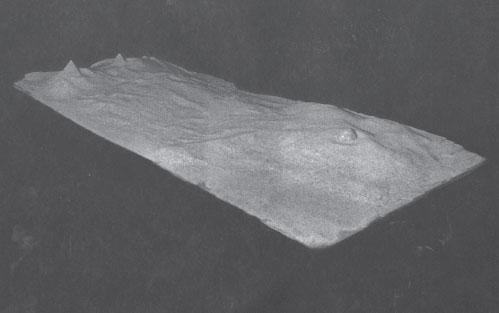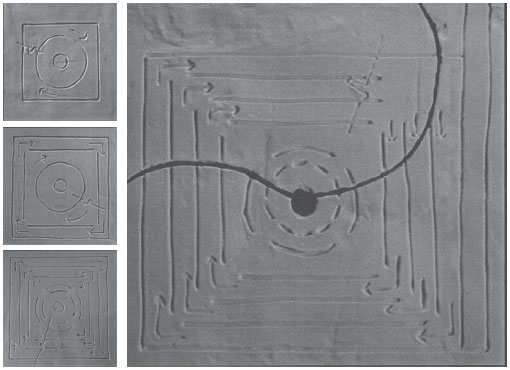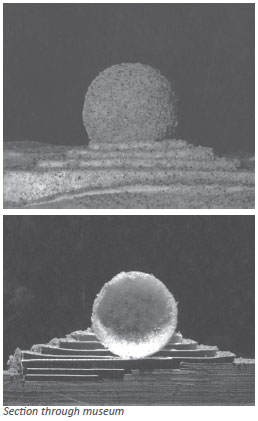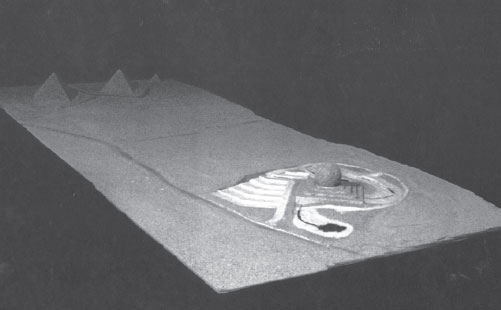

Guiza, Egypt
2003
Competition
Collaborative effort of Nezar AlSayyad and Gordon Gee

Like the pyramids, which were covered in sand for centuries, the Grand Egyptian Museum is unveiled by blowing winds from the desert exposing its form as a Step Pyramid.
A desert site of sand dunes. The museum starts as a ramp that climbs the site. As it circles around, a Step Pyramid is formed. A spinning sphere simulating the sun falls onto the top of the pyramid. A crater with a spiral groove results, forming the museum’s circulation system. A circulation system for the museum is born up the ramp and down the spiral.
 The retaining wall of the ramp collects visitors from the adjacent parking lot. The rooftops of the Step Pyramid form a hanging garden.
The retaining wall of the ramp collects visitors from the adjacent parking lot. The rooftops of the Step Pyramid form a hanging garden.
Once inside the pyramid, the visitors enter the exhibition, which gently ramps up four levels. Once on top, a central ramp spirals down to the center where an interior pool is placed.
Alternatively, visitor may go directly to the center to experience the huge dome before starting to view the exhibits. The inside of the dome, like a planetarium, is used for virtual video projections including heritage exhibitions. In either case, the different display itineraries are organized around this circulation system.
A park system, starting with the lake at the highest point of the site, forms a canal simulating the Nile.
A theme park on both banks, connected by bridges, simulates the Nile valley, as it descends to the lowest point on the site. The water penetrates the pyramid and forms a pool within before continuing its journey, culminating in a pond at the base of the ramp. The banks of the canal contain the performance stages of the different themes, which are arranged chronologically; Ancient Egypt, Greco-Roman Egypt, Coptic Egypt, Islamic Egypt, with Contemporary Egypt occupying the lowest plateau next to the vehicular entrance to the site.

Fig. 1 Sand Dunes
Fig. 2. Museum starts as a ramp climbing thesite.
Fig. 3 As the ramp circles around, a step pyramid is formed.
Fig. 4 A spinning sphere simulating the sun falls on the site.
Fig. 5 A sphere lands on top of the pyramid.
Fig. 6 A crater with a spiral groove results, forming the major space of the museum.
 The museum galleries are along a continuous gently rising spiral that wraps around the central domed hall. The displays are chronological with parallel display halls covering the five thematic topics; the Land of Egypt; Kingship and State; Man, Society, and Work; and Culture and Religion.
The museum galleries are along a continuous gently rising spiral that wraps around the central domed hall. The displays are chronological with parallel display halls covering the five thematic topics; the Land of Egypt; Kingship and State; Man, Society, and Work; and Culture and Religion.
Movement can be either linear or across thematic topics. At anytime, the visitor may leap to a different time period or them by entering the central hall, which serves all levels.
The exterior open-air park system is organized around a water channel evoking the Nile. Exterior displays connect the predominantly ancient Egyptian collection with Egypt’s rich heritage of Greco-Roman, Coptic, and Pharaonic artifacts.
Inside, the dome is used for virtual projection. Much like a planetarium the audience can view presentations from the central hall. The interior of the dome also serves as the virtual like to the Egyptian collection in the various museums of the world as they are projected in hologram form. The show is further enhanced by 3-D projections that simulate for the viewer the experience of walking through some of the major temples of ancient Egypt.
Egypt is the land of pyramids. Our project attempts to return conceptually to the pyramid form without replicating it. The idea of a sun that emerges from the pyramid or sits on it may be linked to ancient Egyptian imagery.
 It is however a very functional idea as it employs a great dome to span over the large central hall of the museum.
It is however a very functional idea as it employs a great dome to span over the large central hall of the museum.
Once inside the pyramid, visitors enter the exhibition, which gently ramps up four levels. Once on top, a central ramp spirals down to the center where an interior pool is placed.
Alternatively, visitors may go directly to the center to experience the huge dome before starting to view the exhibits. The inside of the dome, like a planetarium, is used for virtual video projections including heritage exhibitions. In either case, the different display itineraries are organized around this circulation system.